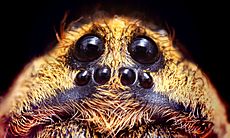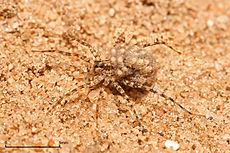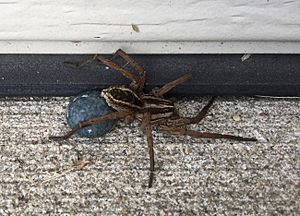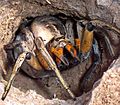Wolf spider facts for kids
Quick facts for kids Wolf spiders |
|
|---|---|
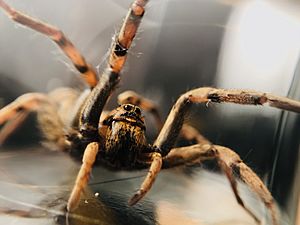 |
|
| Wolf Spider | |
| Scientific classification |
|
| Kingdom: | Animalia |
| Phylum: | Arthropoda |
| Subphylum: | Chelicerata |
| Class: | Arachnida |
| Order: | Araneae |
| Infraorder: | Araneomorphae |
| Superfamily: | Lycosoidea |
| Family: | Lycosidae Sundevall, 1833 |
| Diversity | |
| 124 genera, 2888 species | |
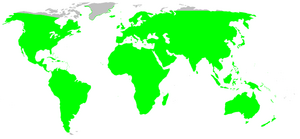 |
|
Wolf spiders are part of the spider family Lycosidae. Their name comes from the Greek word lykos, which means wolf. These spiders are strong and quick hunters with amazing eyesight.
Most wolf spiders live alone and hunt by themselves. They do not build webs to catch their food. Some wolf spiders wait for prey to come by, then they pounce on it. Others chase their prey over short distances. Some even wait for food near the entrance of their burrows.
Wolf spiders look a bit like nursery web spiders. But you can tell them apart by how they carry their eggs. Wolf spiders carry their egg sacs attached to their spinnerets (at the end of their body). Nursery web spiders carry their egg sacs with their mouthparts. Wolf spiders also have two very large eyes in the middle row of their eight eyes. This helps tell them apart from nursery web spiders, whose eyes are all about the same size. It also helps tell them apart from grass spiders.
Contents
About Wolf Spiders
Wolf spiders come in many sizes. Their bodies (without legs) can be from about 1 to 3.5 centimeters long. They have eight eyes arranged in three rows. The bottom row has four small eyes. The middle row has two very large eyes. The top row has two medium-sized eyes. Unlike many other spiders that can't see well, wolf spiders have excellent vision.
Their four larger eyes have a special reflective layer called a tapetum lucidum. This layer helps them see better in low light. If you shine a light on a wolf spider, its eyes will glow. This is because the light bounces off this special layer and back to you. Wolf spiders have some of the best eyesight among spiders. Only jumping spiders and huntsman spiders see better. Jumping spiders can even see colors!
Reproduction and Caring for Young
Wolf spiders are special in how they care for their eggs and young. The female spider spins a round, silken egg sac. She attaches this sac to her spinnerets. This lets her carry her eggs with her wherever she goes. She has to hold her body up to keep the egg sac from dragging on the ground. Even with this extra weight, she can still hunt!
After the spiderlings (baby spiders) hatch from the egg sac, they climb onto their mother's legs. They crowd onto her back. The mother carries her babies for several weeks. She protects them until they are big enough to go off on their own. No other spiders are known to carry their young on their backs like this for so long.
Appearance and Habitat
Wolf spiders use camouflage to stay safe. This means their colors usually match their surroundings. They don't have bright, flashy colors like some other spiders. Their colors help them blend in with their favorite places to live.
The Hogna group has some of the largest wolf spiders. In the U.S., the Carolina wolf spider is the biggest. Its body can be over 2.5 centimeters long. It is dark brown. Sometimes, people confuse it with H. helluo, which is a bit smaller and has different colors. The Carolina wolf spider has a solid black underside. But H. helluo has a mix of reds, oranges, yellows, and blacks on its underside.
Some wolf spiders, like the Carolina wolf spider, dig deep, tube-shaped burrows. They spend a lot of time hiding in these burrows. Others, like H. helluo, find shelter under rocks or other natural spots. In the fall, male wolf spiders sometimes wander into homes. They are usually looking for females to mate with.
Wolf spiders are helpful because they eat many insects. Farmers and gardeners often like them because they help control pests.
Wolf Spider Bites
Wolf spiders will bite if they feel threatened or are bothered a lot. Their bites usually cause mild swelling, a little pain, and itching. In the past, some people thought wolf spider bites caused serious skin damage. But studies have shown that these problems were likely caused by bites from other types of spiders. Australian wolf spiders were also thought to cause bad wounds, but careful research proved this was not true for them either.
Evolutionary History
Wolf spiders probably first appeared after the event that wiped out the dinosaurs, about 66 million years ago. Most of the main groups of wolf spiders likely developed between 41 and 32 million years ago.
Where Wolf Spiders Live
Wolf spiders live in many different places, both near the coast and inland. You can find them in bushy areas, forests, wet coastal woods, mountain meadows, gardens, and even inside homes. Baby wolf spiders can travel through the air, which helps them spread out widely.
Some wolf spiders need very specific places to live, like gravel beds next to streams. But most wolf spiders wander around and don't have a permanent home. Some species dig burrows. These burrows might be open or have a trap door. Wolf spiders in dry areas might build towers or plug their holes with leaves and pebbles during rainy seasons. This protects them from floods. You can often find them in sheds and other outdoor buildings.
Mating Behavior
Many wolf spider species have interesting ways of finding a mate. Males often have special features, like tufts of hair on their legs or unique colors. These features are usually on their front legs. They might have longer hairs, swollen leg parts, or longer front legs compared to their other legs.
Wolf spiders use different ways to attract females. For example, in the Schizocosa group, males often make sounds by rubbing their legs together or drumming their front legs on the ground. Some also use visual signals, like waving their front legs in the air. This shows they use both sound and sight to impress females.
Because wolf spiders often wander, finding a mate can be tricky. Female wolf spiders that have already mated are more likely to eat the next male that tries to mate with them. Males that have already mated have a better chance of mating again. But females that have already mated are less likely to mate again.
Wolf Spiders in Culture
In 2000, South Carolina named the Carolina wolf spider (Hogna carolinensis) as its official state spider. This happened because of the hard work of Skyler B. Hutto, a third-grade student. At that time, South Carolina was the only U.S. state with an official state spider. In 2015, North Carolina also started efforts to name its own state spider.
Images for kids
See also
 In Spanish: Licósidos para niños
In Spanish: Licósidos para niños
- List of spiders associated with cutaneous reactions
- List of Lycosidae species


